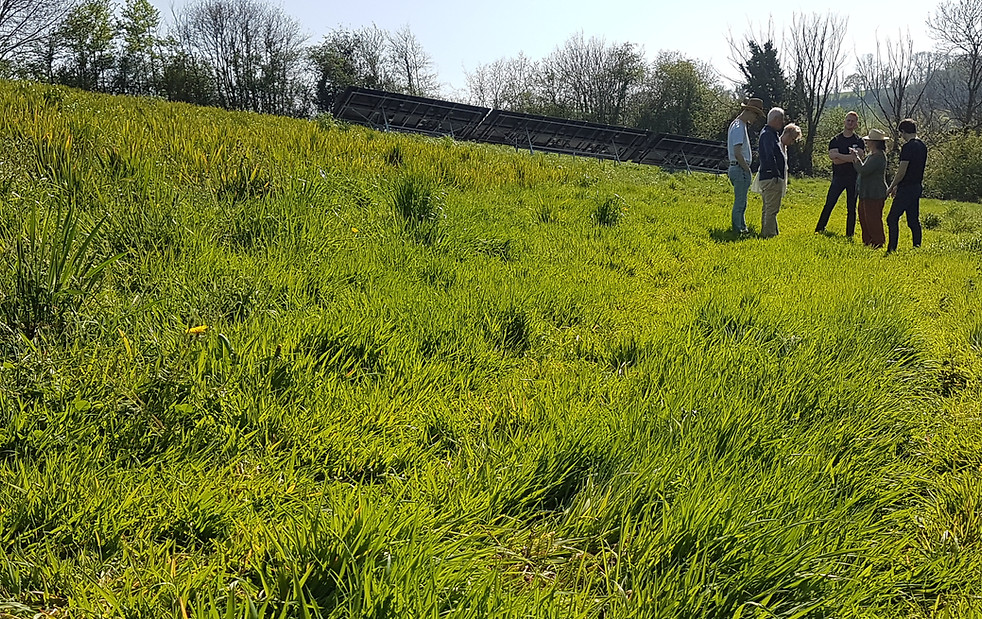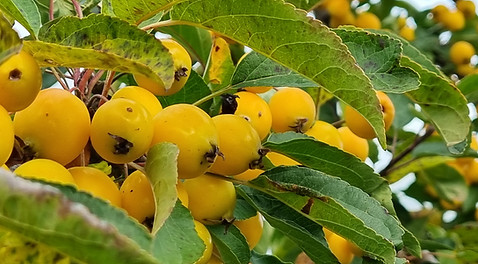
Our Food Forest vision is to create an organic, species-rich agroforest that will be a source of good food and a space to nurture wellbeing. We will grow plants using permaculture principles, thus building in more resilience to climate change than monoculture farming.
According to the UN, 55% of people live in urban areas and this will rise to over 68% by 2050. That’s a lot of people who are living away from the land and the source of food that feeds them. As a result, many people have a disconnection from the land and a misunderstanding as to how vital it is to look after soil properly.
As a small step, we are turning a slightly-acidic field of weedy grassland into a sustainable edible agroforest. We are planting 200 species within this acre. And, around the Food Forest, we have planted a shelter belt and hedge of 500 trees, all native species. This will expand a wildlife corridor and provide protection for the agroforest. As they grow, these trees will create a protected, diverse micro-climate in which we hope to grow grapes, almonds, figs and kiwi fruit (to name but a few of the more ‘exotic’ species).
The agroforest will be organic and will follow ‘regenerative agriculture’ principles, to recreate the rich leaf-litter compost that exists in light woodland. So, we’ll be using ‘no dig’ and ‘ground cover’ practices, to help improve the soil structure.
What is agroforestry?
An agroforest (Food Forest) is a robust perennial edible system, usually split into layers. It is created by growing trees and agricultural crops on the same piece of land. The design provides edible crop products and, at the same time, protects, diversifies and sustains the soil and ecosystem.
When mature, an agroforest is an interactive and sustainable ecosystem, resilient to environmental changes and pests. So, in a small area, you might find fruits, nuts, hops, herbs, natural dyes and coppiced firewood.
See Sue's video below for more on agrofestry (thanks to Philippa from Nub News):

If you’d like to learn more about how agroforestry, at a larger scale, can provide food in more commercial volumes, as well as generate employment, then watch this inspiring talk by David Wolfe of Wakelyns Farm – a 50 acre enterprise that is supporting 5 micro-businesses.
The start – a greenfield site

This is where we began in 2018. With an agricultural field that had been set aside for many years.
There was a reasonable covering of grass along with a selection of nettles, dandelion, creeping buttercup, thistles and ragwort. It was a fine site to turn into an agroforest!
So, the first stage was to cover the grass with matting to kill off the existing vegetation and to put up a deer-proof and rabbit-proof fence to protect what we would be planting.
We dug a pond to encourage more bio-diversity and, within weeks of filling the pond, frogs and newts (both smooth and palmate) had arrived. The pond is now a thriving ecosystem with lots of plant and animal species.
In the first two years, we have removed much of the mulch matting, put in thousands of plants and then added more mulch, in the forms of woodchip and mushroom compost, to raise the pH of the soil and improve the organic content. The woodchip does three things for the soil and plants:
-
it suppresses the growth of plants we don’t want
-
it reduces water loss in hot weather
-
it breaks down and releases nutrients into the soil for the plants



Some of the 150 species planted so far…
The Italian alder canopy layer were mere 60cm ‘whips’ when we planted them in 2019. Within 3 seasons they had grown to over 4 metres! As the trees put on this phenomenal amount of biomass, they fix carbon from the atmosphere. This canopy layer provides light shading and the leaves act as a natural fertiliser.
The next layer down is fruit trees including quince, almond, crab apple, cider apple and maple.
Lower down still we have planted perennial shrubs like allspice, wineberry and honeyberry. Below those are cranberry, loganberry and Szechuan pepper.
Then we drop down to plantings of squash, rosa rugosa (for jam) and blackcurrants (for vitamin C-rich winter tonics). Potatoes are also useful to help break up the clay soil.
The herbaceous layer includes edibles (e.g. salad burnet, sorrel, lettuce) and medicinals (e.g. calendula, lavender, hyssop, chamomile).
In the extended drought of summer 2022, almost all our trees and shrubs survived. And that was without any supplementary watering. Why? The mottled shade and ground cover kept the moisture in the soil. Additionally, a 15cm layer of woodchip acted as a protective mulch. The result? The agroforest was noticeably more humid and green than the grass pasture next to it.


.jpg)

Polytunnel experiments
Near the agroforest is a polytunnel where we can extend the growing season, just as in a greenhouse. As well as annual food crops (tomatoes, aubergines, salad greens, melons), we have planted some perennial fruits (peach, blueberries, apricot, nectarine and pomegranate).
Learning what works and what doesn’t, we have successfully over-wintered liquorice. However turmeric and ginger have not survived winter in here, so these get moved inside, temporarily.
Water is a real issue for growing in any polytunnel. There is neither stream nor tap nearby. Instead, we can collect 8 tonnes of rainwater from the roof into recycled castor oil tanks. A solar-powered pump moves the water from the bottom tank to the top header tank. Then a timed gravity-fed dripper distributes water inside the polytunnel around sunrise and sunset. This reduces the amount of water that is lost through evaporation.


Wildlife spotted

Roe Deer
Badger
Fox
Tawny owl chick
Short-eared owl
Hawk
Red kite
Swift
Mallard
Rook
Vole
Field mouse
Dormouse
Lots of species of ladybirds, wasps, bees, aphids, butterflies, beetles and moths



1 year of change

1st May 2021 - we had a very cold Spring so plants were slow to start growing this year.

19th May 2022 - just one year later! The mulch matting has been replaced with plants, compost and woodchip.
Thanks to Jerome for these 2 photos.
